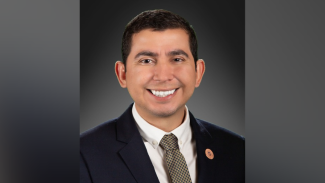
Politics and architecture: Advocacy through design
Christian Solorio Acuña, AIA, NOMA, combines his design skills and public service to tackle low-income housing. Jordan Kravitz, AIA, from the Young Architects Forum, profiles the former member of the Arizona State House of Representatives.

Christian Solorio Acuña, AIA, NOMA, is closing the gap of political inaction and demonstrating actionable advocacy within our profession. Growing up, Christian’s family experienced extreme financial and housing hardship. However, no matter how much his family struggled, his mother taught him there was always something they could do to help other community members who were struggling too. Whether it was donating the clothing he and his brother had grown out of or volunteering at food pantries, Christian began to find purpose through acts of service.
In high school, Acuña was able to participate in a program in partnership with Arizona State University. The program exposed at risk students to the design profession. He was immediately drawn to architecture when he saw the power of design and its ability to uplift. Leaning into his desire to give back to his community he decided to pursue a degree in architecture.
After graduating college with his architectural degree, Acuña started his career in the K-12 education sector. He had attended K-12 in an inner-city school district with “bad buildings'' and he wanted to be able to provide good learning environments for all students. Christian, however, was still living in the low-income community he grew up in. He began to see the direct impacts that the Arizona housing crisis had on the hard-working families that were in his neighborhood.
According to the National Low Income Housing Coalition, in Arizona, there is a shortage of affordable rental homes available to those whose incomes are at or below the poverty guideline or 30% of their area median income1. The rental crisis also disproportionately affects Black, Latino and Native American people, who are more likely to be renters and more likely to be extremely low income.
Understanding that Arizona needed more low-income housing, Christian decided to act. With his continual desire to give back to the community that helped his family during difficult times, he left the K-12 architectural sector and began designing affordable housing. Despite making housing as many people as possible in safe, affordable housing as quickly as possible his architectural priority, it was still taking him three to give years to only open 10 to 80 units at a time. Christian knew that his neighbors were still struggling; people were sacrificing basic needs such as food, clothes, and healthcare just to pay rent. He decided he could do more. With a sense of urgency, he began taking actions outside his nine-to-five job. He would show up to community meetings and other organized events knowing he just wanted to help with the issue of affordable housing.
After working on numerous community initiatives, he proved his dedication to his neighborhood. In 2021, his community asked him to represent them in the Arizona House of Representatives. He had only worked tangentially to politics until this point. Albeit surprised to be tapped on the shoulder, he was honored to serve, represent and advocate for the district that he had lived in for 25 years. Extremely well versed in issues surrounding education, transportation, sustainability, health, and land use, he was able to bring his unique perspective as an architect to the state capitol. Christian explains that architects are trained to view “problems differently, more holistically.” Legislation relating to building and infrastructure was being completely ignored before Christian took office. Christian challenges that policies and politics affect our profession. Decisions by our policymakers are made with us without the input of architects. Why wouldn’t we want our input heard? It is “our responsibility of architects to be there and we cannot complain if we did not set up to say something,” said Acuña.
Although Acuña’s term ended in 2022, his community involvement did not. In addition to working at Architectural Resource Team in Arizona, he is also a member of the Alhambra Elementary School District Governing Board and is the Government Affairs representative on AIA Arizona 2023 Board of Directors. Now is in a position where he “is a problem seeker more than a problem solver," Acuña vows he will continue solving problems to create more affordable housing.
